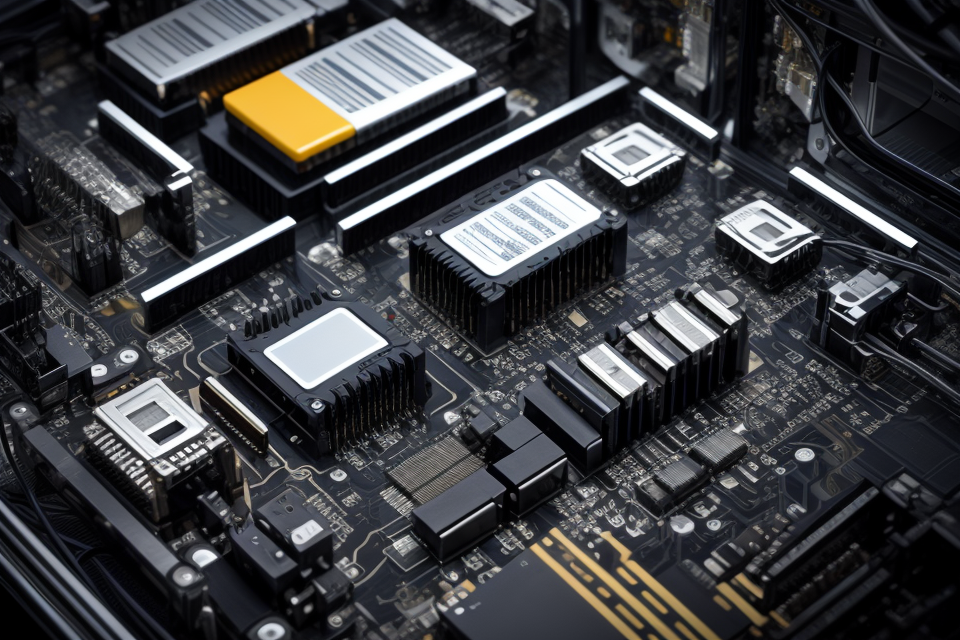
A hardware specification document is a comprehensive guide that outlines the technical specifications of a hardware product. It provides a detailed description of the hardware components, their features, and functionalities. The document also includes information about the performance, compatibility, and operational requirements of the hardware. The purpose of a hardware specification document is to provide a clear and concise guide for engineers, designers, and other stakeholders involved in the development and production of the hardware product.
Hardware specification documents are essential for ensuring that the hardware product meets the desired specifications and functions as intended. It helps to prevent errors and miscommunications during the development process and ensures that the final product is reliable, efficient, and meets the needs of the end-users. A well-written hardware specification document can save time, reduce costs, and improve the overall quality of the hardware product.
What is a Hardware Specification Document?
Definition
A hardware specification document is a detailed and comprehensive description of the technical requirements and characteristics of a computer system or component. It outlines the specifications of the hardware components, such as the processor, memory, storage, and peripherals, along with their intended use and any other relevant information. The purpose of a hardware specification document is to provide a clear and concise overview of the hardware requirements and capabilities, allowing for effective communication between stakeholders, such as designers, engineers, and manufacturers.
Purpose
A hardware specification document is a comprehensive and detailed description of the hardware components required for a particular system or application. The primary purpose of this document is to provide a clear and concise guide for hardware vendors, system integrators, and other stakeholders to ensure that the hardware meets the necessary requirements and functions as intended. This document serves as a reference point for all parties involved in the hardware procurement and implementation process.
In addition to providing a detailed description of the hardware components, the hardware specification document also outlines the required interfaces, communication protocols, and power requirements. The document may also include specifications for environmental factors such as temperature, humidity, and vibration.
By having a well-defined hardware specification document, it is possible to avoid potential hardware-related issues and ensure that the hardware components are compatible with the rest of the system. This can save time and money by avoiding costly rework or replacement of hardware components.
Overall, the purpose of a hardware specification document is to provide a clear and concise guide for hardware vendors, system integrators, and other stakeholders to ensure that the hardware meets the necessary requirements and functions as intended.
Key Components of a Hardware Specification Document
A hardware specification document is a detailed description of the components and specifications of a hardware system. It provides a comprehensive overview of the hardware’s capabilities and limitations, intended use, and performance requirements.
Hardware Components
A hardware specification document outlines the various components that make up the system, including:
- Processor: The central processing unit (CPU) of the system, responsible for executing instructions and managing operations.
- Memory: The temporary storage space used by the CPU to store data and instructions during processing.
- Storage: The permanent storage space used to store data, applications, and operating systems.
- Peripherals: External devices such as keyboards, mice, monitors, and printers that are connected to the system to enhance its functionality.
Technical Specifications
A hardware specification document also includes technical specifications that describe the system’s physical characteristics and capabilities, such as:
- Form factor: The size and shape of the hardware components, which may affect compatibility with other systems or equipment.
- Power requirements: The amount of power needed to operate the system, which may impact the choice of power supply and the overall energy efficiency of the system.
- Operating temperature range: The range of temperatures within which the system can safely and effectively operate.
- Compatibility with other hardware components: The system’s compatibility with other devices and equipment, which may be a critical factor in some applications.
Intended Use
Finally, a hardware specification document outlines the intended use of the system or application, including:
- Purpose of the system or application: The specific goals and objectives of the system or application, which may include tasks such as data processing, video editing, or gaming.
- Performance requirements: The specific levels of performance required for the system or application to function effectively, such as processing speed, memory capacity, or storage capacity.
- Operating environment: The conditions in which the system or application will be used, such as temperature, humidity, or exposure to dust or other environmental factors.
In summary, a hardware specification document is a critical tool for understanding the capabilities and limitations of a hardware system, ensuring compatibility with other equipment, and ensuring that the system meets the performance requirements of its intended use.
Why is a Hardware Specification Document Important?
Benefits of a Hardware Specification Document
A hardware specification document is an essential tool for any organization that relies on technology. It provides a clear and concise description of the hardware being used or proposed for use, and serves as a reference for hardware vendors, system integrators, and other stakeholders. In addition, a hardware specification document helps ensure that the hardware meets the necessary requirements and functions as intended, and facilitates communication and collaboration among stakeholders.
One of the key benefits of a hardware specification document is that it provides a clear and concise description of the hardware being used or proposed for use. This includes information such as the hardware’s technical specifications, dimensions, and interfaces, as well as any relevant certifications or compliance standards. By having this information in one place, stakeholders can quickly and easily access the information they need to make informed decisions about the hardware.
Another benefit of a hardware specification document is that it serves as a reference for hardware vendors, system integrators, and other stakeholders. This is particularly important in complex systems where multiple vendors are involved, as it ensures that everyone is working from the same set of specifications. It also helps to ensure that the hardware is compatible with other components in the system, and that it meets any necessary requirements.
In addition, a hardware specification document helps to ensure that the hardware meets the necessary requirements and functions as intended. This is particularly important in mission-critical systems, where downtime or failure can have serious consequences. By having a clear and detailed description of the hardware, stakeholders can more easily identify potential issues and take steps to address them before they become problems.
Finally, a hardware specification document facilitates communication and collaboration among stakeholders. By providing a clear and concise description of the hardware, it helps to ensure that everyone is on the same page when it comes to the system’s design and implementation. This can help to reduce misunderstandings and ensure that everyone is working towards the same goals.
Risks of Not Having a Hardware Specification Document
Not having a hardware specification document can lead to several risks and potential issues. These risks include:
- Increased risk of hardware failure or incompatibility: Without a clear and detailed hardware specification document, it becomes difficult to ensure that all components are compatible with each other. This can result in hardware failure or incompatibility issues, which can lead to system downtime, data loss, and other related problems.
- Delays in system or application development: Without a hardware specification document, developers may have to spend more time trying to figure out what hardware components are needed, how they fit together, and how they work. This can lead to delays in system or application development, which can be costly and time-consuming.
- Miscommunication or misunderstanding among stakeholders: Without a clear and detailed hardware specification document, there may be miscommunication or misunderstanding among stakeholders. This can lead to delays in decision-making, project delays, and other related problems.
- Potential for additional costs due to unexpected hardware requirements or issues: Without a hardware specification document, there may be additional costs associated with unexpected hardware requirements or issues. This can include the cost of additional hardware components, the cost of repairing or replacing failed hardware components, and other related costs.
Overall, having a hardware specification document is crucial for ensuring that all hardware components are compatible with each other, reducing the risk of hardware failure or incompatibility, minimizing delays in system or application development, avoiding miscommunication or misunderstanding among stakeholders, and preventing additional costs due to unexpected hardware requirements or issues.
FAQs
1. What is a hardware specification document?
A hardware specification document is a detailed description of the hardware components of a computer system or device. It outlines the various hardware components, their specifications, and their intended use. The document is typically created during the design phase of a project and is used as a reference for hardware selection, testing, and troubleshooting.
2. Why is a hardware specification document important?
A hardware specification document is important because it provides a clear and comprehensive overview of the hardware components of a system. It ensures that all stakeholders have a common understanding of the hardware requirements and specifications, which can help prevent misunderstandings and errors during the design and implementation phases. Additionally, a hardware specification document can serve as a reference for troubleshooting and maintenance activities, helping to ensure that the system operates optimally over its lifecycle.
3. What should be included in a hardware specification document?
A hardware specification document should include detailed information about the hardware components of a system, including the make and model of each component, its specifications, and its intended use. The document should also include any relevant information about the system’s power requirements, cooling requirements, and any other physical constraints that may impact the selection of hardware components. Additionally, the document should specify any interfaces or connectors that are required for the system to function properly.
4. How is a hardware specification document created?
A hardware specification document is typically created during the design phase of a project, and is developed by the system architect or hardware engineer responsible for the project. The document is based on the requirements and specifications of the system, and is created by researching and selecting appropriate hardware components that meet those requirements. The document is then reviewed and approved by relevant stakeholders to ensure that it accurately reflects the hardware requirements of the system.
5. How is a hardware specification document used?
A hardware specification document is used as a reference for hardware selection, testing, and troubleshooting. It can help ensure that the correct hardware components are selected for a system, and can provide guidance for testing and validating the system’s hardware components. Additionally, the document can be used as a reference for maintenance and troubleshooting activities, helping to ensure that the system operates optimally over its lifecycle.







